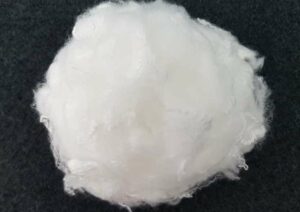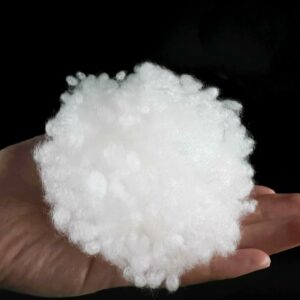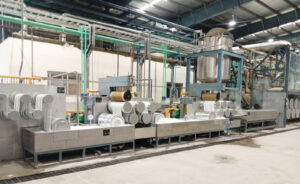Sheep survive by grazing, which can have a positive impact on certain types of ecosystems when it is well managed. But when the land is grazed too heavily, this leads to overgrazing.
Overgrazing means that the vegetation does not have enough time to grow back before it is consumed. The soil becomes weak and vulnerable to erosion and desertification.
For example, 30% of the region of Patagonia is affected by desertification, mainly due to overgrazing by sheep which are primarily raised for their wool.
Sheep also release methane, a gas that is 25 times worse for global warming than CO2. Sheep are often subjected to insecticide baths that contain substances hazardous to the farmers. Residues of those harmful chemicals can remain in the wool and make their way into our clothes.
Animal welfare:
Another concern about wool production is the poor treatment of sheep. When a sheep’s fleece is removed (shearing), the shearers often hurt the animals, cutting their skin or hitting them to keep them quiet. Finally, the practice of mulesing has been widely denounced by animal rights activists. Mulesing involves removing the skin of the Merino sheep around the breech to prevent parasitic infection
Sheep fleece is the raw source of wool. In conventional farming, the sheep are ‘dipped’ in insecticides and fungicides to keep them healthy, and then shorn of their fleece once a year. The fleece is then cleaned and scoured to remove dirt and other impurities (including chemicals from dipping). Scouring also aligns the microscopic barbs in the fleece to give it a smoother feel.
The next stage is ‘carding’ whereby the fleece passes through a series of metal teeth to untangle and straighten the fibers. Depending on the yarn required, the fibers are then combed to remove the shorter lengths and to straighten them further.
Wool can be woven and knitted and blends well. It can absorb almost 30 percent of its own weight in water, making it great for temperature regulation. Wool is still used for a range of clothing from formal suiting to casual knitwear.
Once golden fleeces
Sheep and wool were major sources of revenue in medieval times, becoming vital to the economies of Spain and England from the 1400s to the 1700s. The Industrial Revolution made further fortunes (and intensified worker exploitation) as mechanized mills spun and wove wool in such vast quantities that fleece needed to be imported from Australia and New Zealand1.
The wool trade remained vibrant until around the 1960s when cheaper imports from Asia began to appear, synthetic fibers started to emerge and formal menswear went into decline. Now only around 1 percent of all fibers used in garment production is wool.
Currently, the wool industry produces around 1,160 million kilograms (kg) of clean wool per year from a global herd of around 1.16 billion sheep. Each sheep yields about 4.5kg of wool per year – enough to produce 10 meters of fabric or about six jumpers (sweaters)2. These figures include wool textiles used for items other than garments – for example, furniture or carpets. Global production is valued at around $7.6 billion per year3.
If each sheep produces enough wool for six sweaters per year, the global wool herd of 1.16 billion sheep would, on average, produce enough fiber for 6.9 billion sweaters – just under one sweater per person per year for the entire global population.
Major wool producers are China, Australia, and New Zealand with the UK, Iran, Russia, and South Africa having sizeable production. Australia is the biggest exporter of wool, and China the largest importer.
Recycling vs. negative impacts
Land use, water pollution, and global warming are all negative factors associated with wool production.
The Made-By Environmental Benchmark for Fibres ranks wool as Class E along with conventional cotton and virgin nylon. The Sustainable Apparel Coalition’s Higg Materials Sustainability Index ranks wool’s impact at 82 out of 100, compared to 98 out of100 for cotton, but much higher than polyester at 39.
However, both benchmarks only measure the impact up to the production of yarn or fabric and don’t take into consideration the full lifecycle of the product. As wool is a higher value and longer-wearing fiber, wool products are likely to stay in use longer, be washed less, recycled more, and biodegrade at the end of their life.
According to the International Wool Textile Organisation (IWTO), up to 5 percent by weight of the total clothing donated by consumers for recycling and re-use is wool. The IWTO has a technical advisory group working on ensuring more robust lifecycle assessments for wool.
Calculations around the land use required by wool have also been challenged. The 1.16 billion sheep are also part of the food industry and often raised on land that cannot be used for arable food crops.
Animal welfare is a key issue for wool production. The Responsible Wool Standard (RWS) from Textile Exchange is a voluntary global standard that addresses the welfare of sheep and the land they graze on. The standard also follows the chain of custody from the farm to the final product, so consumers can have confidence in the RWS logo.
The Global Organic Textile Standard (GOTS) also applies to wool. As with all GOTS certification, it covers the processing of the fiber, not its production, which is covered by government organic standards.
Other organizations run voluntary initiatives to improve welfare and traceability:
ZQ Merino: from New Zealand Merino for fully traceable, merino wool.
The Dumfries Declaration: Signatories to the Dumfries Declaration commit their company to abide by ten principles of best practice for the wool industry.
IWTO Specifications for Wool Sheep Welfare: developed by the wool growing country members of IWTO.
Source: https://www.commonobjective.co/article/fibre-briefing-wool





